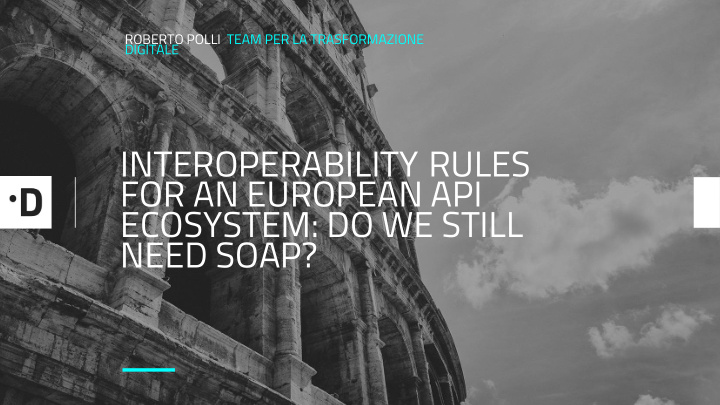



ROBERTO POLLI TEAM PER LA TRASFORMAZIONE DIGITALE INTEROPERABILITY RULES FOR AN EUROPEAN API ECOSYSTEM: DO WE STILL NEED SOAP? —
The Italian Digital Team Old SOAP Framework SOAP & REST Agenda The New Framework Standardization & Reliability Future ideas
Make public services for citizens and businesses accessible in an easy manner, via a mobile first approach, Team Mission with reliable , scalable and fault tolerant architectures , based on clearly defined APIs .
Roberto Polli - love writing in Python, C and Java Who am I RHC{E,VA}, MySQL|MongoDB Certified DBA API Ecosystem @ TeamDigitale
From Enterprise to The Web
The Old SOAP Framework Ad-hoc encapsulation with a custom gateway
The Old SOAP Framework Processing errors (SOAP Faults) required de/serialization of XML No universal semantic for communicating service status (soap faults uses 500 for everything) Errors at peak loads caused further thrashing
The Old SOAP Framework Become a barrier for the creation of new services: - Very expensive (both for setup and maintenance/operation) - Complicates communication with non-governmental agencies - The IT world was moving beyond SOAP
Beyond SOAP SOAP was born in 1999: ● transfer-agnostic messaging protocol (HTTP, SMTP, ..) ● adds one layer, with computational and architectural costs ● virtually asynchronous exchanges (soap messages) Today: ● new HTTP Semantics RFC 7230-7238 released in 2014 ● services are inherently based on HTTP ● synchronous exchanges (eg. mail vs chat)
Beyond SOAP The new semantics allow to: ● route requests using Path and Method (Eg. idempotent vs non-idempotent) ● use Status and Headers for service management, don't have to process the body ● Caching, Conditional and Range Requests, ...
The New Framework ● Standardize HTTP APIs without SOAP ● API-first approach to REST APIs based on OpenAPI v3 ● Scheme standardization based on national, European and industry standards ● Availability strategy based on a distributed circuit-breaker and throttling patterns
The New Ecosystem National IRS School Registry (MEF) (ANPR) Town Police PHR Hospital (FSE)
Standardization
HTTPS Always HTTPS http Wrap queues (kafka, JMS, AMQP, … ) with HTTPS for authentication and authorization binary messages Leverage STATUS, METHOD and PATH for auditing and routing
Logs, dates: RFC5424 / 3339 ago 6 14:04:50 ago-06 18:58:50,000 Aug 02 18:43:47.000 mer 9 ago 08:45:37 CEST 2018 Fri May 05 08:45:37 IST 2018-05-08T10:06:25Z 2018-May-08 10:06:25 AM 2018-05-08T10:06:25.000Z 05/12/2018 2018/12/05 12-05-2018 05/12/2018 2018-12-05 12-05-2018
Ontology-based schemas cod_fiscale tax_code piva fiscalCode CF nato vat_number codice_fisc nome partIva given_name cfiscale nato_a cf p_IVA (from w3id.org/italia) fiscal_code PI name
Reliability
Reliability Business Continuity Plan (European Interoperability Framework) Integrated management of load and failures Avoid cascading failures
Reliability Service management techniques (eg. circuit-breaker)
Service Management Headers Communicate service limits x-rate-limit-minute: 100 X-RateLimit-Retry-After: 11529485261 X-RateLimit-Limit: #request X-RateLimit-UserLimit: 1231513 X-RateLimit-Remaining: #request X-RateLimit-UserRemaining X-RateLimit-Reset: #seconds X-Rate-Limit-Limit: Communicate service status name=rate-limit-1,1000 x-custom-retry-after-ms HTTP 503 (service unavailable) X-Rate-Limit-Remaining-month HTTP 429 (too many requests) X-Rate-Limit-Reset: Wed, 21 Oct 2015 Retry-After: #seconds 07:28:00 GMT x-rate-limit-hour: 1000
Errors: RFC7807 RFC 7807 is an extensible format for errors { "message": "Service Unavailable", "code":  123 }  { "status" : "error", "message": "Unable to communicate with { database" } { "type": " https://tools.ietf.org/html/rfc7231#section-6.6.4 ", "error": { "errors": [ { "reason": "required", "title": "Service Unavailable", "message": "Login Required", "locationType": "detail": "Service is active in forex hours", "header", "location": "Authorization" } ], "code": "status": 503, 401, "message": "Login Required" } }" } {"error": { "instance": "/account/12345/msgs/abc", "code": "501", "message": "Unsupported } functionality", "target": "query", "details": "" }
Future steps
Standardized metrics Readable indicators: - use rates, not absolute values - use basic units (eg. Bytes, seconds, …) - use increasing Service Level Indicators, the higher the better Example: - availability is 0-100% - expose success rates, not error rates
Standardizes metrics Set common and simple indicators: - availability: eg. the service was up for 95% of the time - success_rate: % of successful requests - target_response_time: expected latency at 95p Evaluating: - or responsiveness: the service meet the target_response_time for 90% of the time - or APDEX index:
Signatures and Encryption Signing an exchange with a digital certificate is the basis for a non-repudiation framework. SOAP has a well-established (and criticized) standard for Signing and Encryption REST standards are Json Web Signatures|Encryption RFC7515 used by OpenID Connect (still criticized)
Signatures and Encryption Possible choices: - leave the signature to the application protocol (eg. json) - sign just the body (a sort of ws-security built with JWS) extending the objects with claims or adding an Headers - sign a fingerprint(request,header,body) via Headers Current request/response fingerprint functions and Signature headers proposals (eg. amz, draft-cavage, signed-exchanges)
Further discussions On digital certificates: - RSA is considered a legacy https://github.com/WICG/webpackage/pull/181 - EC keys are easily embedded in claims and headers On Headers - evaluate Structured Headers Example-DictHeader: en="Applepie", da=*w4ZibGV0w6ZydGUK=* - deprecate or adopt Digest
References
New Italian Framework https://forum.italia.it/c/piano-triennale/interoperabilita http://lg-modellointeroperabilita.readthedocs.io/it/latest/
Roberto Polli roberto@teamdigitale.governo.it @ioggstream @teamdigitaleIT @team-per-la-trasformazione-digitale teamdigitale.governo.it
Recommend
More recommend